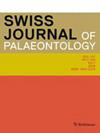Orthoceratoid and coleoid cephalopods from the Middle Triassic of Switzerland with an updated taxonomic framework for Triassic Orthoceratoidea
IF 2.2
2区 地球科学
Q1 PALEONTOLOGY
引用次数: 0
Abstract
Orthoconic cephalopods are subordinate, but persistent, widespread and regionally abundant components of Triassic marine ecosystems. Here, we describe unpublished specimens from the Anisian (Middle Triassic) Besano Formation at Monte San Giorgio, Switzerland. They can be assigned to two major but unrelated lineages, the Coleoidea and the Orthoceratoidea. The orthoceratoids belong to Trematoceras elegans (Münster, 1841) and occur regularly within the Besano Formation, are uniform in size, and have few available morphological characters. In contrast, coleoids are more diverse and appear to be restricted to shorter intervals. A new coleoid is described as Ticinoteuthis chuchichaeschtli gen. et sp. nov. To better put the orthoceratoids of the Besano Formation into perspective, we also synthesise the current taxonomy of Triassic orthoceratoids on a global scale. The currently used scheme is largely outdated, with very little taxonomic progress in the past 100 years. Despite previous research showing the distinctness of Triassic orthoceratoids from Palaeozoic taxa, they are still commonly labelled as “Orthoceras” or “Michelinoceras”, which are confined to the Palaeozoic. We show that Triassic orthoceratoids probably belong to a single lineage, the Trematoceratidae, which can be assigned to the Pseudorthocerida based on the embryonic shell and endosiphuncular deposits. Many Triassic species can probably be assigned to Trematoceras, but there are at least two additional Triassic orthoceratoid genera, Paratrematoceras and Pseudotemperoceras. Finally, we review the palaeobiogeographic and stratigraphic distribution of the group and outline possible future research directions.瑞士中三叠世的正角类和鞘状头足类动物,以及更新的三叠世正角类动物分类框架
直齿头足类是三叠纪海洋生态系统中从属但持久、广泛和区域性的丰富成分。在这里,我们描述了来自瑞士圣乔治山安息(中三叠世)贝萨诺地层的未发表标本。这些标本可归属于两个主要但不相关的类群:鞘翅目(Coleoidea)和正戟目(Orthoceratoidea)。正角类属于 Trematoceras elegans(Münster,1841 年),经常出现在贝萨诺地层中,大小一致,几乎没有可用的形态特征。相比之下,鞘状石的种类更多,而且似乎仅限于较短的间隔。一种新的鞘状类被描述为 Ticinoteuthis chuchichaeschtli gen.为了更好地认识贝萨诺地层的正角类,我们还综合了目前全球范围内三叠纪正角类的分类方法。目前使用的分类方法在很大程度上已经过时,在过去的 100 年中分类工作进展甚微。尽管之前的研究表明三叠纪正长岩类群与古生代类群截然不同,但它们仍然通常被标记为 "Orthoceras "或 "Michelinoceras",仅限于古生代。我们的研究表明,三叠纪的直角戟类可能属于一个单系,即 Trematoceratidae,根据胚壳和内鞘沉积物,可将其归入假直角戟类。三叠纪的许多物种可能归属于Trematoceras,但至少还有另外两个三叠纪正角类属:Paratrematoceras和Pseudotemperoceras。最后,我们回顾了该类群的古生物地理和地层分布情况,并概述了未来可能的研究方向。
本文章由计算机程序翻译,如有差异,请以英文原文为准。
求助全文
约1分钟内获得全文
求助全文
来源期刊

Swiss Journal of Palaeontology
Earth and Planetary Sciences-Paleontology
CiteScore
4.30
自引率
16.70%
发文量
17
审稿时长
4 weeks
期刊介绍:
The Swiss Journal of Palaeontology publishes original research and review articles of interest to the international community in the fields of palaeontology, taxonomy and systematics, while recognising at the same time the importance of documenting high-quality palaeontological data in a regional context. Palaeobiology in combination with alpha taxonomy is a core topic of the journal.
Submitted papers should have an appeal as wide as possible, directed towards an international readership. Contributions should not have been simultaneously submitted elsewhere, and the overlap of content between related articles should be minimal. Duplications of text and the use of previously published illustrations without adequate citation are unacceptable. If a manuscript has two or more authors, both or all have to sign to confirm they all were involved in the work and have agreed to its submission. The preferred manuscript language is UK English, but consistently used US English is also acceptable. We encourage the publication of proceedings of international meetings as well as special thematic issues. Short contributions and book reviews are also accepted.
An international editorial team as well as guest editors guarantee that the thematic issues as well as all articles in regular issues are peer-reviewed and meet the highest standards.
 求助内容:
求助内容: 应助结果提醒方式:
应助结果提醒方式:


